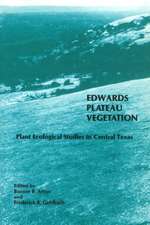Raven Biology of Plants
Autor Peter H. Raven, Susan E. Eichorn, Ray F. Everten Limba Engleză Hardback – 28 mai 2012
Long acclaimed as the definitive introductory botany text, Raven Biology of Plants stands as the most significant revision in the book's history. Every topic was updated with information obtained from the most recent primary literature, making the book valuable for both students and professionals.
This textbook is available with LaunchPad. LaunchPad combines an interactive ebook with high-quality multimedia content and ready-made assessment options, including LearningCurve adaptive quizzing. See 'Instructor Resources' and 'Student Resources' for further information.
Preț: 489.68 lei
Preț vechi: 719.46 lei
-32% Nou
93.71€ • 101.76$ • 78.72£
Carte disponibilă
Livrare economică 02-16 aprilie
Livrare express 18-22 martie pentru 124.92 lei
Specificații
ISBN-10: 1464113513
Pagini: 900
Ilustrații: Illustrations
Dimensiuni: 239 x 283 x 32 mm
Greutate: 2.1 kg
Ediția:Revizuită
Editura: W H FREEMAN & CO LTD
Locul publicării:New York, United States
Descriere
The eighth edition of the highly regarded botany textbook Raven Biology of Plants by Ray F. Evert and Susan E. Eichhorn offers the most significant revision in the book's history.
Every topic has been updated with information from the most recent primary literature. The chapters have been carefully reorganized, with extensive updating of the Diversity Section and the Angiosperm Plant Body Section. The text also includes new photos, illustrations and chapter openers, making the text even more accessible and engaging.
Biology of Plants presents an emphasis on the interrelationships of growth and development, structure and function, and evolution and ecology. A highlight of the new edition is a set of 8 new ecology essays that showcase ecologically relevant stories to bring the concepts to life. They cover a range of topics, from "Google Earth: A Tool for Discovering and Protecting Biodiversity" to the "Doomsday Seed Vault: Securing Crop Diversity" and "Green Roofs: A Cool Alternative".
In addition, a number of supplements will support both you and your students in using Biology of Plants to its full potential.
Cuprins
Botany: An Introduction
PART I: THE BIOLOGY OF THE PLANT CELL
The Molecular Composition of Plant Cells
The Plant Cell and the Cell Cycle
The Movement of Substances Into and Out of Cells
PART II: ENERGETICS
The Flow of Energy
Respiration
Photosynthesis, Light, and Life
PART III: GENETICS AND EVOLUTION
Sexual Reproduction and Heredity
The Chemistry of Heredity and Gene Expression
Recombinant DNA Technology, Plant Biotechnology, and Genomics
The Process of Evolution
PART IV: DIVERSITY
Systematics: The Science of Biological Diversity
Prokaryotes and Viruses
Fungi
Algae and Heterotrophic Protists
Bryophytes
Seedless Vascular Plants
Gymnosperms
Introduction to the Angiosperms
Evolution of the Angiosperms
Plants and People
PART V: THE ANGIOSPERM PLANT BODY: STRUCTURE AND DEVELOPMENT
Early Development of the Plant Body
Cells and Tissues of the Plant Body
The Root: Structure and Development
The Shoot: Primary Structure and Development
Secondary Growth in Stems
PART VI: PHYSIOLOGY OF SEED PLANTS
Regulating Growth and Development: The Plant Hormones
External Factors and Plant Growth
Plant Nutrition and Soils
The Movement of Water and Solutes in Plants
PART VII: ECOLOGY (AVAILABLE ON THE COMPANION WEBSITE)
The Dynamics of Communities and Ecosystems
Global Ecology
Appendix: Classification of Organisms
Suggestions for Further Reading
Glossary
Notă biografică
Caracteristici
Caracteristici noi
- The Diversity Section has been updated based on the emergence of molecular systematics and the comparison of DNA and RNA sequences. Most of the chapters have been reorganized. The latest taxon names have been introduced. All of the cladograms have been revised. The principle of monophyly is followed throughout.
- Significant revision ofthe Physiology of Seed Plants Section. New information has been incorporated in each chapter, including such topics as hormone receptors, the formation of lateral roots, the floral stimulus, thigmonastic movements, strategies to acquire nutrients, nocturnal transpiration, and hydraulic redistribution.
8 NEW ECOLOGY-ORIENTED ESSAYS:
Written by a science writer, these essaysnow supplement the existing ecology-themed essays, e.g.:
- Global Warming:The Future is Now
- Invasive Plants
- Google Earth: A Tool for Discovering and ProtectingBiodiversity
- Coral Reefs and Global Warming
- Doomsday Seed Vault: Securing Crop Diversity
- Green Roofs: A Cool Alternative
MORE ACCESSIBLE - Each chapter has been carefully revised to make it as accessible as possible:
- Thenarrative is clearly written, carefully explained, and well illustrated.
MORE ILLUSTRATIONS, MORE STUDENT ENGAGEMENT:
- Approximately 175 new illustrations and photographs have been added.
- NEW chapter-opening photos and short captions present topics of interest, including ecological applications, that engage students from the first moment they encounter each chapter













